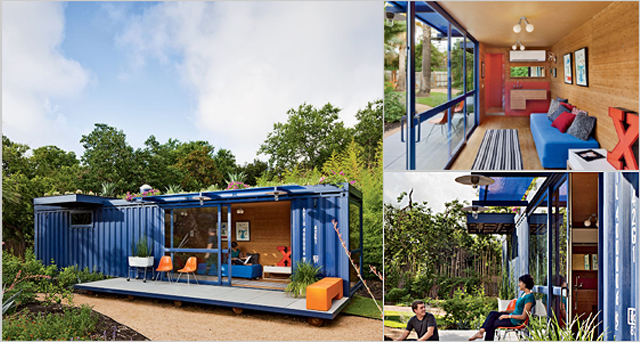sierraclub.org - sierra magazine - january/february 2011 - comfort zone
Thinking Inside the Box
By Erika Heet

Clockwise from above: Glass walls help transform a shipping container into a guest room, while original markings proclaim its early life; durable and renewable bamboo covers the floor and walls; and polycarbonate sheets shade the porch, which is lit by lamps made from recycled tractor parts. | Photos by Chris Cooper
"The large windows and sliding glass door," says Stacey Hill. "The natural light is fantastic, and when I look out into the yard, the container feels huge."
"One of the biggest surprises was the cost to finish out the container," Hill says. "I really wanted it to look great, so I decided on more expensive finishes."
From the moment Stacey Hill started reading about the potential of shipping containers as housing a few years ago, she was hooked. Seeking extra room for her two young daughters to play in, as well as a separate space for guests visiting the San Antonio, Texas, artists' community she calls home, Hill selected an electric blue "one-shipper," a relatively pristine container that had made just one overseas shipment.
"It was a very simple process," she says. "I paid by credit card, and it was freighted to me from La Porte, near Houston."
It's also the epitome of "reduce, reuse, recycle." A crane dropped the 40-foot container, which cost less than $6,000, into place, and Texas architect Jim Poteet began making the 320-square-foot box livable—and green. (Upgrades to the container tripled the initial cost; one-third of the container is used for storage space.)
On one side he installed floor-to-ceiling windows and a sliding glass door to maximize light and air flow. Spray-foam insulation keeps the container cool in summer and warm in winter; a succulent-covered green roof further insulates by absorbing sunlight.
"We wanted solar panels, but they were too expensive," Hill says. "The rooftop garden was our next choice. I couldn't be happier."
She turns on a small, energy-efficient air conditioner only on the most scorching Texas days, recycles graywater from the sink and shower to hydrate the rooftop garden, and saves thousands of gallons of freshwater per year with an electric composting toilet.
"Because of this project I have begun composting most of our food waste, started a garden, and am purchasing two water cisterns for another project," Hill says. "Once I began to adopt more environmentally friendly ways of living, it spread more and more into my life."
ON THE WEB What's your idea of a green living or work space?
Tell us at sierraclub.org/sierra/shelter.